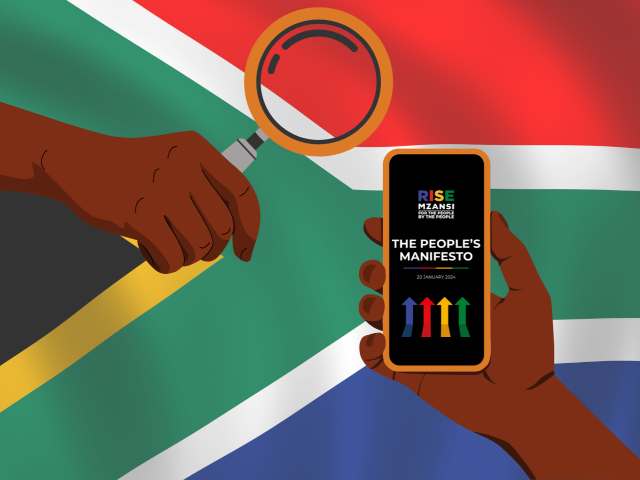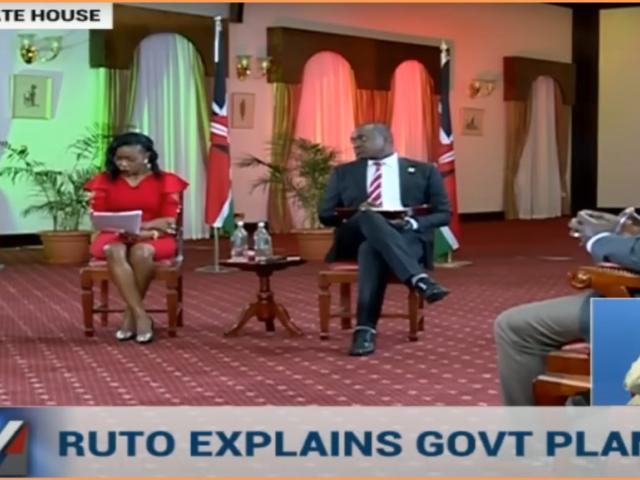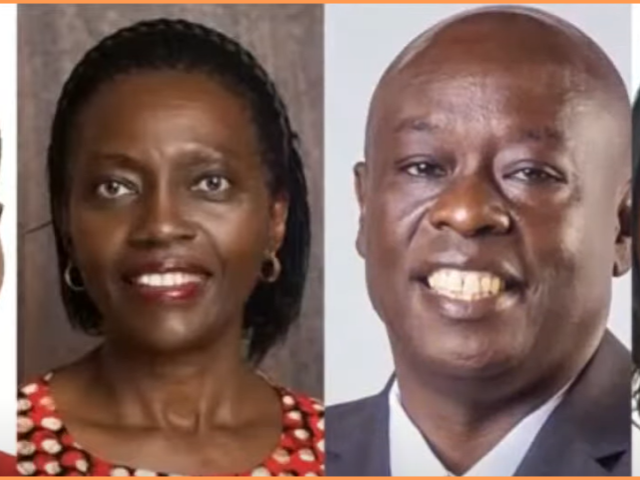-
Ruto is right that there were significantly fewer election petitions filed after the 2022 elections than in 2017, but a governance expert told us it wasn't easy to discern the reasons for this.
-
The president was also mostly right about the split between the number of jobs in the informal versus the formal sector – 83% to 17 % – and about the high number of Kenyans living in slums.
-
Ruto was however on shakier ground when it came to financial institutions and lenders, including erroneously claiming that 10 million Kenyans were blacklisted by credit reference bureaus.
Kenya’s president William Ruto recently took advantage of a national holiday to make a number of claims about the economy and society.
The country celebrated 60 years of self-government on 1 June 2023. The holiday is known as Madaraka Day.
Ruto has held the top job since September 2022. He was previously deputy president since 2013.
We looked at some of the claims he made in his speech.
Ruto became president after a hard-fought election and a legal challenge to his narrow victory of 50.49% of the vote. His main rival, Raila Odinga, has refused to recognise him and has taken to leading regular opposition protests.
On Madaraka Day, Ruto revisited the August 2022 general elections and praised the electoral commission for setting “a new high in election management”.
“In fact, the openness and credibility of the 2022 election are affirmed by the fewer petitions filed; 124 petitions compared to 303 petitions in 2017,” Ruto said.
Election petitions are court cases in which a candidate's election victory is at issue.
Were there fewer petitions filed in 2022 than in the 2017 general elections?
In 2017, 299 election petitions were filed for the five elective seats – governor, senator, county women's representative, member of the national assembly and member of the county assembly.
This is according to the Independent Electoral and Boundaries Commission (IEBC), which organised the vote.
In addition, there were four presidential election petitions, bringing the total to 303. The country’s judiciary also listed all the petitions.
In 2022, the IEBC recorded 124 petitions for the five elective seats and nine presidential petitions, for a total of 131 petitions. (Note: Ruto’s figure excludes presidential petitions.)
These figures show that there were fewer petitions filed in 2022 than in 2017. We therefore rate this claim as correct.
Reasons for fewer election petitions not straightforward
Ruto attributed the lower number to “the openness and credibility of the 2022 election”.
This is harder to establish. Dr Roukaya Kasenally is the chairperson of the Electoral Institute for Sustainable Democracy in Africa (Eisa), a non-profit organisation that promotes credible elections.
She told Africa Check that the credibility of elections has several parameters. Kasenally, a democracy scholar and associate professor of media and political systems at the University of Mauritius, said the IEBC could have corrected the flaws of the 2017 elections before the 2022 polls.
Civil society, the media and election observers could also have played a role in reducing the challenges in 2022.
“If one or both of the above statements can be ascertained, then the claim could be right and this is due to a collective understanding and action of turning electoral threats into electoral good practices which then ensure open and credible elections,” Kasenally told Africa Check by email.
The IEBC attributed the drop in the number of election petitions to “adequate training” of election officials. Ahead of the 2022 elections it published an operational plan that it said included lessons learned from past elections.
In a preliminary report on the 2022 elections, the Carter Center, an international observer, highlighted the benefits of using technology. – Tess Wandia.
“A huge number of Kenyans, about 10 million, had either been blacklisted by the credit reference bureaus, over inability to pay loans … or were struggling to pay,” Ruto said. This, he said, was one of many barriers to the economic well-being of Kenyans.
Credit reference bureaus (CRBs) are institutions that collect information on borrowers. Kenya’s central bank has licensed three CRBs: CreditInfo CRB, Metropol CRB and Transunion Kenya CRB.
A similar claim was made in a Business Daily article on 2 February 2021, which put the number of Kenyans listed by a CRB at 14 million.
This figure was also used by now deputy president Rigathi Gachagua during a nationally televised debate in July 2022 during the election campaign.
But that claim was debunked by Kenyan TV station KTN News in a “fact-finder” segment.
In an interview with the station on 16 February 2021, Metropol’s group managing director Sam Omukoko said the 14 million figure was the number of blacklisted loan accounts, not people.
“On average when you check through the bureau of records, Kenyans have an average of about five accounts, borrowing from banks, MFIs [and] saccos,” Omukoko said. MFIs are microfinance institutions, while saccos are savings and credit societies.
“So you may find an account in the bank is in default but an account in the sacco is performing well or an MFI is performing well. So, that is the kind of thing that we are talking about. It was not about the number of people who have defaulted and been listed in the credit reference bureaus,” he explained.
He added that the “average default figure” was three million.
The Central Bank of Kenya put the figure at 4.2 million on 14 November 2022, but this figure only includes those who have borrowed from the commercial banks it regulates. These control 74% of the digital lending market, according to a 2021 report by Kenya’s competition authority.
The regulator’s figure does not include those who borrowed from unregulated digital lenders.
We rate this claim as incorrect. – Dancan Bwire
Ruto said most jobs are informal. The informal sector refers to “all small-scale activities that are semi-organised, unregulated and use low and straightforward technologies”. This is according to the Kenya National Bureau of Statistics, which collects data on employment and publishes it in the annual economic survey.
These include small-scale traders, craftspeople and entrepreneurs.
The most recent survey by the data agency, published in 2023, showed that 15.3 million people worked in the informal sector in Kenya in 2021. This was provisionally estimated to have increased to 15.96 million in 2022.
The total number of employed Kenyans in 2022 was 19.15 million. This means about 83.3% of employees were in the informal sector.
While the president used the older 2021 figure of 15.3 million, the informal sector still accounts for 83.3% of the total employment, using the latest figures.
We rate this claim as mostly correct. – Makinia Juma.
The formal sector refers to jobs with regulated hours, wages, employment rights and income tax paid on earnings.
The latest survey showed that 3.2 million people, or 16.7%, were employed in the formal sector in 2022, up from 3.1 million, or 16.9%, in 2021.
We rate this claim as mostly correct. – Makinia Juma.
Safaricom is the largest telecommunications company in Kenya. It operates M-Pesa, a popular mobile money service that allows people to send, receive, borrow money or make payments.
The Hustler Fund is a flagship government initiative to provide affordable credit to Kenyans working in the informal sector. The money is paid into the mobile money wallets of Kenyan telephone companies, including M-Pesa.
The fund was launched in November 2022, with Kenyans able to access the funding from December 2022.
But did Safaricom really add two million subscribers after the fund was launched?
The company's chief executive, Peter Ndegwa, told Citizen TV in Kenya that the increase in those borrowing from the Hustler Fund had encouraged more people to use M-Pesa for accessible credit.
“We have actually seen two million people who were not actively interacting with M-Pesa, coming back into M-Pesa and actually borrowing,” Ndegwa said on 18 May.
In its latest audited financial reports, Safaricom gives the average monthly number of M-Pesa subscribers.
|
Safaricom’s average monthly active M-Pesa subscribers (2020-2023) |
||
|---|---|---|
|
Year |
Active subscribers (million) |
Change (million) |
|
2020 |
24.91 |
- |
|
2021 |
28.31 |
3.4 |
|
2022 |
30.53 |
2.22 |
|
2023 |
32.11 |
1.58 |
According to data published on Safaricom's website, 1.58 million more Kenyans became M-Pesa subscribers in the year between 1 April 2022 and 31 March 2023.
We have asked Safaricom for month-on-month figures of active M-Pesa subscribers since November 2022, when the Hustler Fund was launched, until 1 June, when the president spoke, to verify the figures. Until we hear back, we rate this claim as unproven. – Tess Wandia.
In his speech, Ruto said “seven million Kenyans live in slums in indignity without toilets, without running water and without roads”.
The United Nations Human Settlements Programme defines slums as areas where households lack durable housing, adequate living space, secure tenure, easy access to safe water or adequate sanitation facilities.
Kenya’s 2019 census puts the total urban population at 14.8 million. The latest UN data on the urban population living in slums showed that 50.8%, or 7.6 million people, lived in slums in 2020. This figure is also used by the World Bank.
We fact-checked the president in May 2023 when he put this figure at six million and found it to be incorrect. After our fact-check was published, he revised it to seven million. That's still about 600,000 people too few, but we rate the claim mostly correct. – Tess Wandia








Add new comment